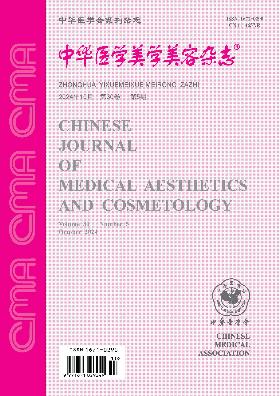Lab color measurements of Ota nevus, freckles and melasma
引用次数: 0
Abstract
Objective Lab color mode can be used to digitize the color. This study explores the possibility of using Lab model to measure facial pigmentations. Methods Lab color model was used to measure the normal skin and three common clinical pigmentations (Ota nevus, freckles and melasma). We also analyzed the characteristics and assessed the data changes after the treatment. Results Average L, a and b values were 54.4, 13.8 and 19.0 in normal skin, 34.6, 5.17 and 6.9 in Ota nevus, 43.25, 16.15 and 23.05 in freckles and 40.5, 16.8 and 23.35 in melasma, respectively. The Lab values of freckles and melasma were close. The order of L value was: normal skin > freckle > melasma > Ota nevus; the order of value of a and b was: melasma > freckle > normal skin > Ota nevus. After treatment, the Lab values gradually tended to be the values of normal skin. Conclusions The Lab color mode can be used as a digital description method for skin color and facial pigmentation, which provides an objective measure for clinical research. Key words: Nevus of Ota; Freckles; Chloasma; Melanosomes; Lab color model; Digital description太田痣、雀斑和黄褐斑的实验室颜色测量
目标实验室颜色模式可用于数字化颜色。本研究探讨了使用Lab模型测量面部色素的可能性。方法采用实验室彩色模型对正常皮肤和临床常见的三种色素(太田痣、雀斑和黄褐斑)进行测量。我们还分析了这些特征,并评估了治疗后的数据变化。结果正常皮肤的L、a、b平均值分别为54.4、13.8和19.0,太田痣为34.6、5.17和6.9,雀斑为43.25、16.15和23.05,黄褐斑为40.5、16.8和23.35。雀斑和黄褐斑的实验室值接近。L值的大小顺序为:正常皮肤>雀斑>黄褐斑>太田痣;a值和b值的顺序为:黄褐斑>雀斑>正常皮肤>太田痣。治疗后,Lab值逐渐趋于正常皮肤的值。结论Lab颜色模式可以作为皮肤颜色和面部色素沉着的数字描述方法,为临床研究提供了客观的测量手段。关键词:太田痣;雀斑;黄褐斑;黑色素体;实验室颜色模型;数字描述
本文章由计算机程序翻译,如有差异,请以英文原文为准。
求助全文
约1分钟内获得全文
求助全文
来源期刊
自引率
0.00%
发文量
4641
期刊介绍:
"Chinese Journal of Medical Aesthetics and Cosmetology" is a high-end academic journal focusing on the basic theoretical research and clinical application of medical aesthetics and cosmetology. In March 2002, it was included in the statistical source journals of Chinese scientific and technological papers of the Ministry of Science and Technology, and has been included in the full-text retrieval system of "China Journal Network", "Chinese Academic Journals (CD-ROM Edition)" and "China Academic Journals Comprehensive Evaluation Database". Publishes research and applications in cosmetic surgery, cosmetic dermatology, cosmetic dentistry, cosmetic internal medicine, physical cosmetology, drug cosmetology, traditional Chinese medicine cosmetology and beauty care. Columns include: clinical treatises, experimental research, medical aesthetics, experience summaries, case reports, technological innovations, reviews, lectures, etc.

 求助内容:
求助内容: 应助结果提醒方式:
应助结果提醒方式:


